“Only accurate rifles are interesting.” Though the value of this statement is contested in gun articles back then and today, Americans have always been able to shoot well. Being a frontier nation at the time of its origin, and having the right to bear arms affirmed in the Constitution, meat has been put on the table, and various opponents put on the ground due to rifles over the course of the 240 year history of the country.
As this is a practical article, I’ll gloss over entire swaths of history here. Gunpowder is considered to have been invented in China in the 13th century and may have been independently developed elsewhere at the same time. Referred to as black powder today, it was originally a fireworks propellant, and was fashioned into single shot weapons that spread through the Middle East and into Europe.
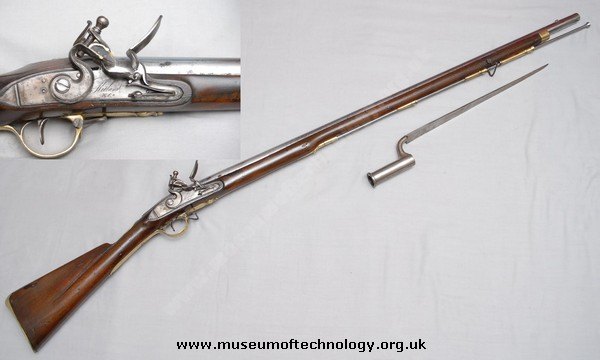
British Brown Bess with bayonet.
By the time the American colonies got established, the gun technology of the day, along with the idea of pikes and spears, got combined into a fairly standardized infantry musket with a bayonet.
Muskets
Muskets had some similar traits to cannons, with size being an obvious exception. You would pour a measure of powder down the bore, and drop in a ball that was often undersize for the bore of the musket, and use the ramrod stored under the barrel.
Point the business end down range, cock back your hammer off to the side of the gun (often a piece of flint against a steel striker, the “flintlock”) and prime the pan with some fine grade powder. Shoulder it, pull the trigger, and hopefully the thing fires, sending your ball rattling down the bore to inaccurately fly some short yardage before running out of velocity and hitting the ground.
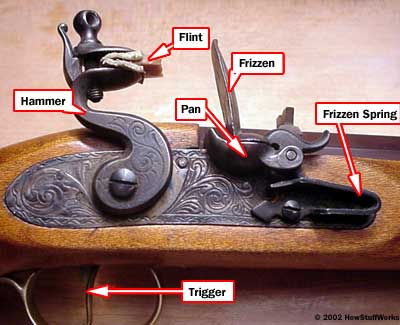
Flintlock Detail.
Some improvements to the process were made with the first “cartridges,” which were paper wraps of a measure of gunpowder and a ball. You bit the end off, primed the pan, poured the rest down the barrel, then flipped the wrapper over and shoved the whole thing, ball first, down the barrel. This also cleaned the bore a bit, kept the ball securely against the powder, and stabilized it going down the bore in flight.
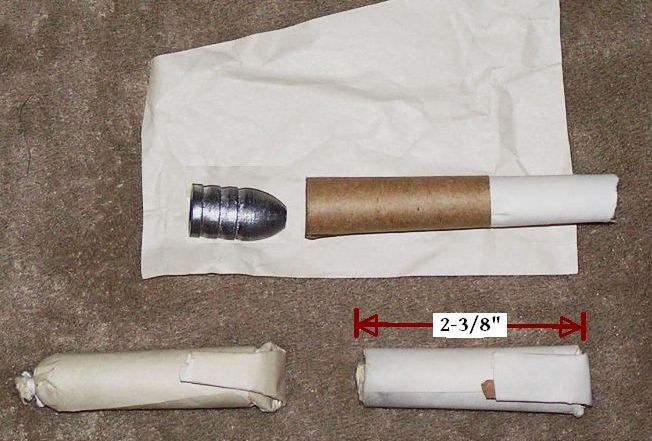
Paper Cartridge and Minie Ball Civil War era design
Rifling
There was really no difference between the historical equivalent of a shotgun versus predecessors to rifles, other than putting in shot vs. ball. Rifling is what makes a gun accurate, and is a number of grooves cut into a barrel that are helical in nature and serve to spin a projectile as it goes down the bore. Although there are newer types of rifling like polygonal, traditional rifling is composed of lands and grooves, where the lands are what contacts the bullet and spins it as it moves down the barrel.
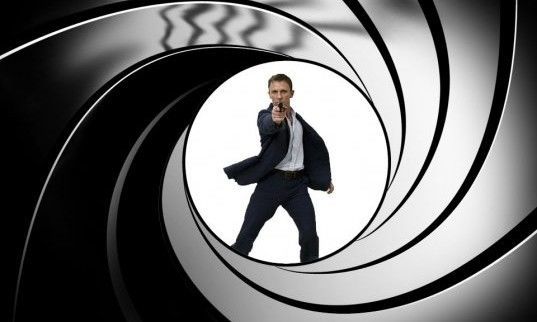
Stylized rifling surrounding Bond is the trademark of the “gun barrel opener” of all Bond movies.
Rifling requires a tight fit. Bullets have diameters in between the larger diameter of the grooves, and the smaller diameter of the lands for a press fit. This is not a problem with modern breechloading rifles where the bullet will simply sit behind the rifling’s start when chambered, but it was a real bitch to shove a ball down a rifled muzzleloader’s barrel compared to the undersized ball in a smoothbore musket mentioned earlier.
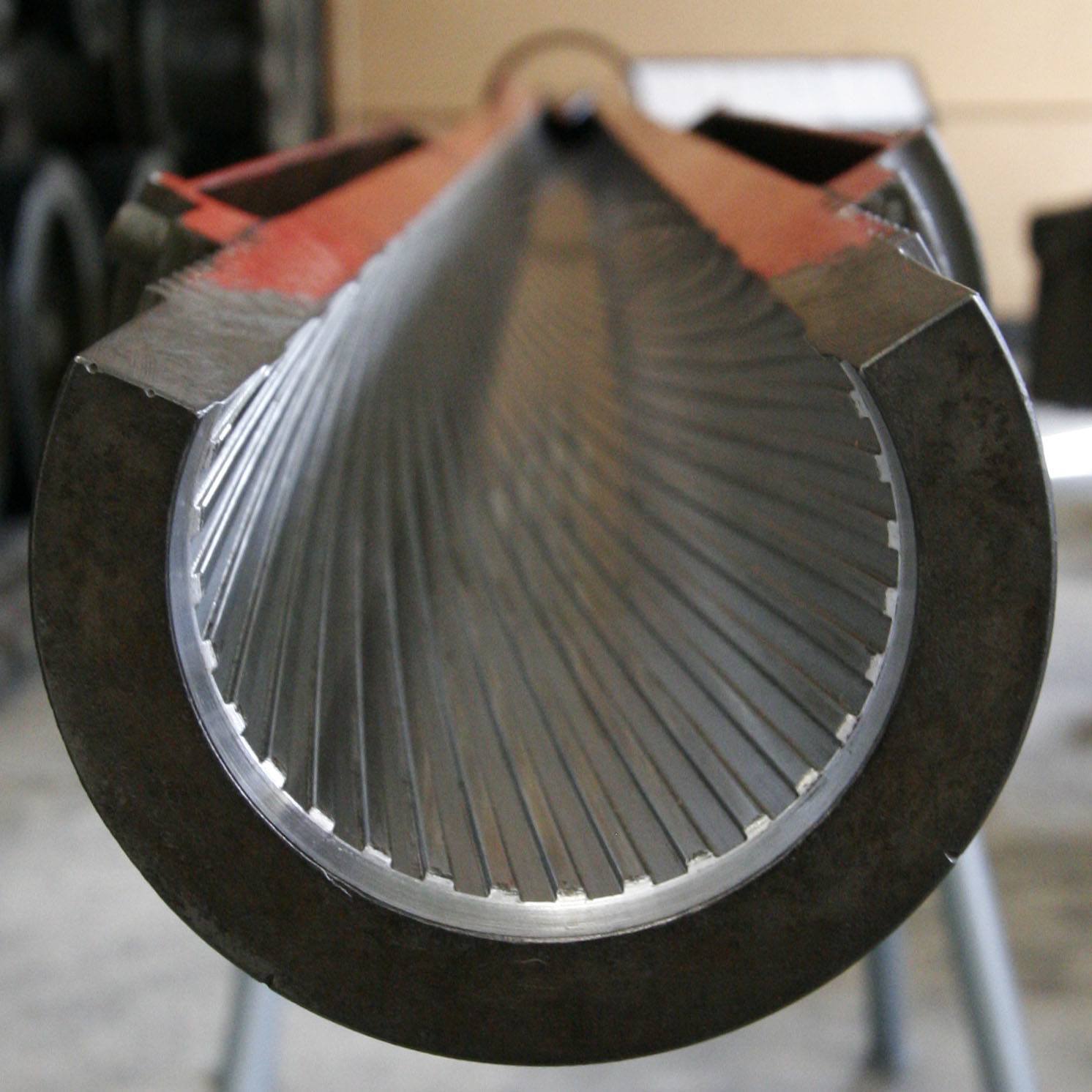
Rifling on a tank gun
However, people in the colonies that weren’t in the cities had to hunt and deal with the occasional Indian group, so knowing how to shoot once and kill something was more important than multiple shots that might not hit anything, and the tradeoff of the long loading time was worth the increased accuracy.
Groups like Morgan’s Riflemen and others used the Kentucky Rifle to great psychological effect, even though there weren’t many of them. Something about some guy sneaking out of the trees and shooting you from twice the distance that you could manage scared the British Regulars.
Blackpowder Cartridges
The Civil War was an absolute mess in armament, and beyond the scope of this article to cover much of it, but there were a few technical advances that should be addressed.
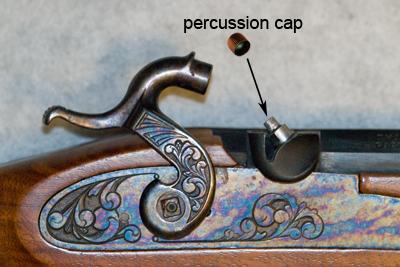
The percussion cap is a small amount of priming compound inside a copper cup, and it is the direct predecessor of the modern primer. It replaced the flint and steel , and also provided its own fuel for the ignition blast. Modern muzzleloaders can still use percussion caps, though they are usually inline, not off to the side like they were back then, and most of them use modern primers in little plastic discs that you can reload after use.
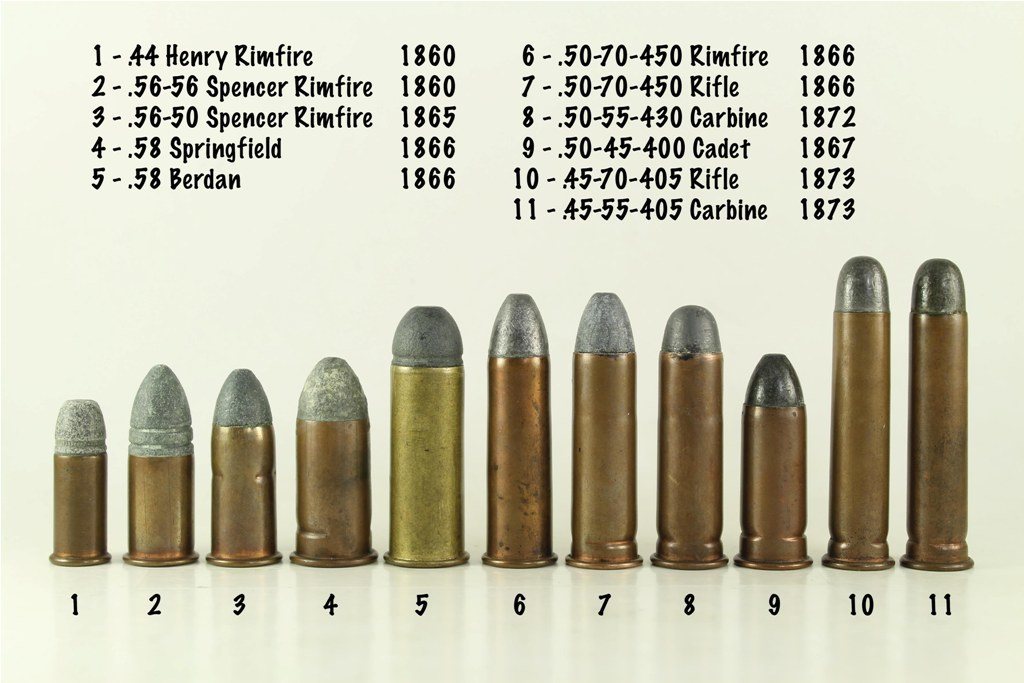
Blackpowder cartridges.
The other advance was breechloading cartridges. The original ones were carryovers from the muzzleloader cartridge; paper or linen packages with a bullet and a charge. The Sharps rifle used these cartridges, loaded from the breech, and a percussion cap.
Brass cartridges soon followed. Rimfires (the .22 Short, one of the originals, is still around today, albeit with smokeless powder) and a now-obsolete ignition type called the pinfire were the two methods. Rimfires have priming compound in the rim and the hammer crushed it to fire. Pinfires had a pin sticking out the side which punched a primer inside the cartridge for ignition.
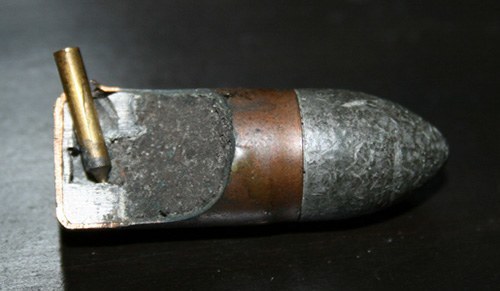
Cross-section of a pinfire. The pin crushed the priming compound below it when fired.
Flammable cartridges would conveniently burn themselves up upon use, and you simply reloaded, but a brass cartridge has to be extracted before reloading can occur. Rimfires were pulled out by their rims, and the pinfires were pulled out by the end of the pin after firing. Rimmed cartridges would continue in this fashion until centerfire cartridges and the necessity for box magazines made rebated rims necessary.
Although copper cartridges were briefly used, centerfire brass cartridges soon became standard soon after the Civil War. The 1873 Springfield “Trapdoor” rifle is interesting due to it being almost a modern single shot rifle and using one of the oldest cartridges still around, the 45-70.
Repeaters, a manual action rifle that could hold multiple rounds of ammunition, showed up in the Civil War (notably the Spencer Carbine), and carried over into the days of Western expansion. The Henry Rifle, was noted for being “a rifle you could load on Sunday and shoot all week long” due to being it able to hold 17 rounds, which was unheard of at the time.
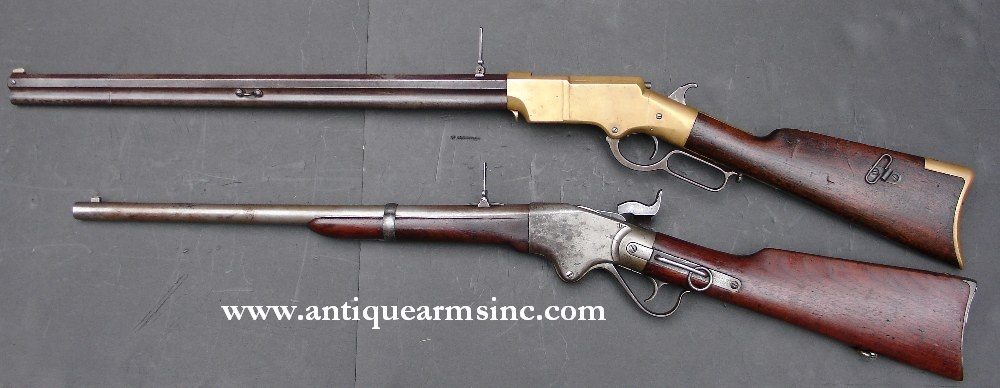
Early repeaters. Henry Rifle on top (magazine under barrel) and Spencer Carbine (magazine in buttstock.)
Spitzer Bullets, Smokeless Powder, And Machine Guns
Although the Gatling Gun was used in the Civil War, it was not a machine gun. Rather, it was a crank operated, multiple barreled, manual action gun, but it was still damned impressive for running on black powder. The Maxim gun was the first true machine gun, arriving in the 1880s.
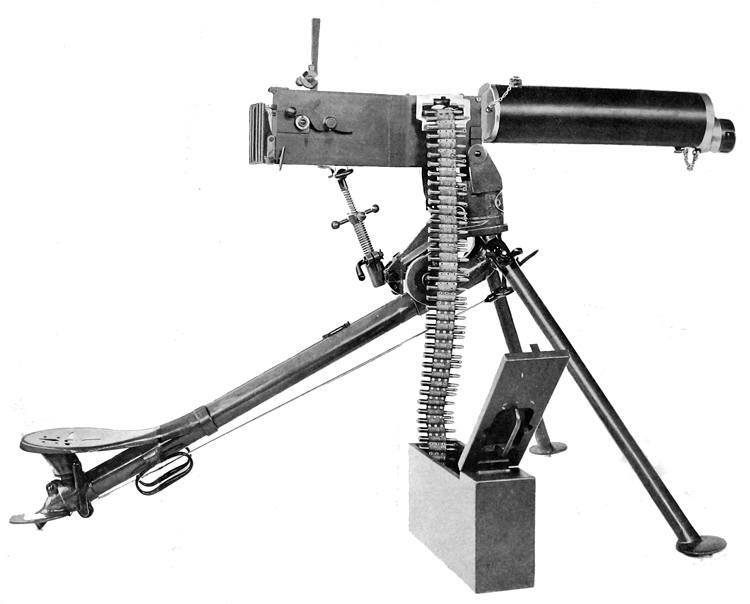
1904 Maxim Gun
Smokeless powder, of multiple chemical formulas, was developed in the late 1800s, and was primarily conceived to reduce fouling. The residue left over from black powder combustion; fouling is corrosive, sticky, and gunks up a gun in a hurry. Smokeless powder is more powerful, cleaner, and doesn’t blow clouds of black smoke.
Although smokeless powder comes mainly in commercial ammo to end users today, it’s also available in bottles for reloading. Never load a blackpowder weapon of any type with smokeless powder.
Spitzer bullets were the third major improvement of the time. Previously, bullets had been cylinders with hemispherical, or close to it, tips. Spitzer, which means spire, bullets have a point, and are much more aerodynamically efficient. Calibers got smaller, and went from typically .45 or so down to .30 (7.62 mm) and was a lot closer to the current aerodynamic rage of 6.5mm .26 cal bullets than a .45 cal ball nose.
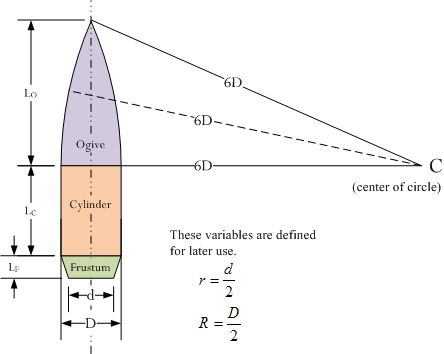
Spitzer bullet geometry
Pointy bullets were wanted by the military so that fire could be done at longer ranges. With modern powder, solid bolt actions were developed by many countries (Britain, Russia, Germany, and the US) and that set up armaments for the first World War, which was primarily a rifles and machine guns fight.
Auto-loading Rifles And Submachine Guns.
Armaments developed to a certain extent between the World Wars. Machine guns increased their cyclic rate and became somewhat more portable. Bolt action rifles also carried over, as did revolvers and semi-automatic pistols running recoil actions.
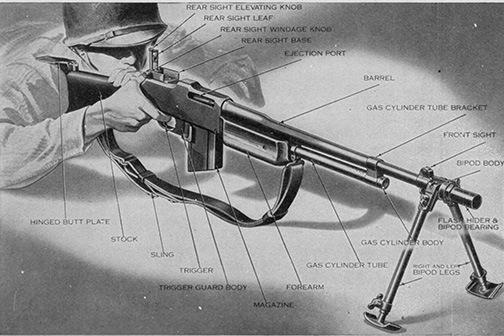
Browning Automatic Rifle.
Automatic actions were present, but the concept of getting them into man-portable units was approached in a number of creative ways that showed up in the Second World War. Downsized “light” machine guns, like the Browning Automatic Rifle were select fire, heavy personal weapons firing full sized rifle cartridges like the 30-06. Fully automatic carbines firing pistol cartridges (submachine guns or machine pistols) were also developed. Some carbine sized rifles, like the US M1 Carbine, were also used in the conflict.

M1 Carbine with sling, magazine, mag pouch, and stripper clip.
Most WWII standard battle rifles were bolt action, with the notable exception of the M1 Garand (see title photo) that was semi-automatic, and deserves its own article. The other notable weapon of that conflict was the German StG-44, which was the abbreviation of Sturmgewehr model 1944.
Intermediate Cartridges And Assault Rifles
Literally “storm rifle” (as in to storm a position, or assault it), this is where the term “assault rifle” comes from. Automatic rifle fire is an awesome thing, but, even though a battle rifle like the M1918 BAR mentioned above, or the M14 that was the successor to the M1 Garand, or its contemporaries the German G3 or the Belgian FAL, amongst others, will be able to handle fully automatic fire from a full power rifle cartridge, you will not be able to hold the rifle on target under sustained fire.
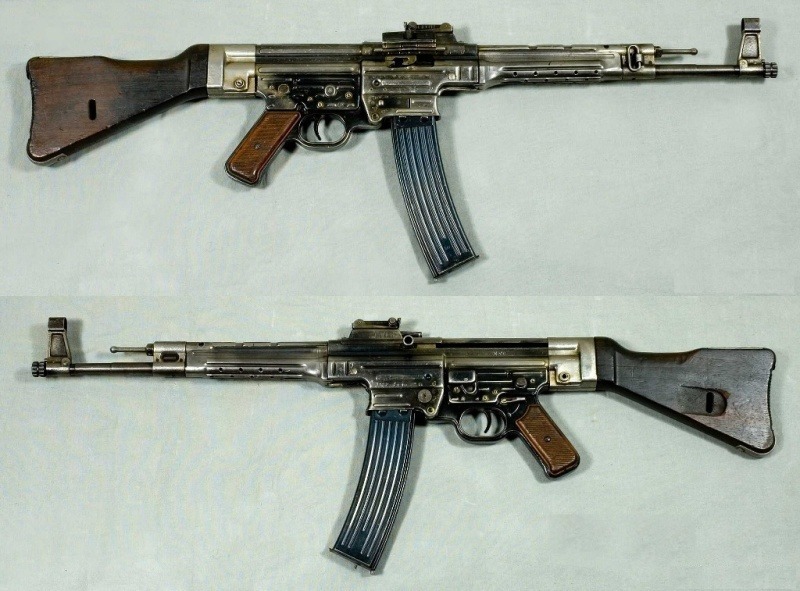
StG-44, the first Assault Rifle.
Enter the intermediate cartridge, and the bargain of trading a full rifle cartridge for a smaller one that can be controlled under automatic fire and be carried in much greater amounts. An assault rifle is an intermediate sized cartridge firing rifle that is capable of select fire. Select fire is the term for multiple firing modes, usually safety, single shot, and multiple shots per trigger pull, with the latter either being a burst of a number of rounds (three is usual) or fully automatic fire.
The two principle assault rifles of the 20th century are the AK-47 (and later AK-74) developed by Mikhail Kalashnikov and the Soviet Union, and the AR-15/M16/M4 Armalite Rifle developed by Eugene Stoner and the USA. Both can be argued as the most influential of rifles of recent times and will get their own write-ups here.
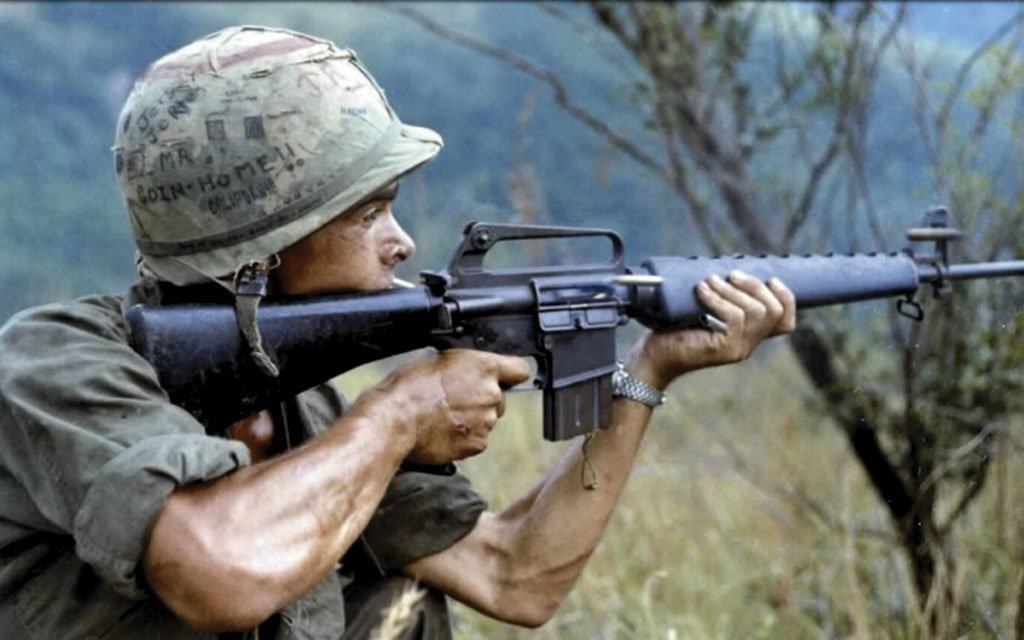
M16A1, Vietnam era.
Bullpups And Modern Advancement
Firearm evolution in the past fifty years has mainly been a development of ergonomics and more powerful cartridges for longer ranges. Bullpup is the industry name for a carbine sized rifle that is shortened in overall length by placing the action just in front of the shooter’s shoulder, instead of the traditional position of in front of the trigger hand. This removes a foot of so of total length at the expense of some complicated trigger mechanisms.

Steyr AUG, the first successful bullpup
To Be Continued…
Next week, we’ll get into action types, common cartridges, different types of rifles available on the civilian market, accessories, and the dreaded Evil Features ™.
Read More: The Fundamentals of Gun Safety
I’m glad to see that you’ve written another firearm article Luke. Thanks for your work on these. You are doing an excellent job.
I’ve never fired a sniper rifle with scope, just handguns and an uzi once. I wonder if there is a place a civilian can learn long-range riflery?
I learned from books and online videos. A good scope is essential, a good scope that’s sighted in is even more essential.
I believe that in some areas you can still get certified in Civilian Marksmanship, the program was developed back during WW2 so that teens could get early training with rifles before entering the military.
http://thecmp.org/
Thanks man, deshi basara!
“Project Appleseed”. I haven’t been to one, but I’ve heard good things about them.
Personally, usually I’d just suggest buying an inexpensive .22 rifle (scope it if you want) and learning to shoot with that first. Then move on to higher powered rifles.
Sadly there is still a major shortage of .22 ammo, so you may want to start with something different instead.
Agree. Open sight .22 is great for learning. Leave scopes alone until you know what you’re doing.
I just sold off my long range precision kit. My reasons:
1.) It’s a rich man’s hobby. Even with the cheapest possible kit, like I tried to do.
2.) It’s a niche skill that takes a lot of time to develop.
3.) It’s not very practical unless you’re trained in everything else a sniper needs- ingress, stalking, egress, etc. It’s easier, cheaper, and more practical to train and equip for CQB.
4.) You need a place to shoot, which depending on where you are in the country, there may be none. I lived in a very rugged mountainous state with tons of public land for 10 years and it was hard to train because there was no beginner’s terrain. And now I live in a very open but completely privately owned state. Getting up and down a 1,000m plus range is important, even if you’re shooting steel. It becomes an ALL DAY EVENT to load up your kit, get the steel, DRIVE to the range, which can take a long time depending on where you are, THEN set up all your crap… finally you shoot and then have to tear down and pack up. You’d best make it a weekend camping/sniping trip.
Glad we can finally chat about something other than religion 🙂
I appreciate the cost and the specialty training for stealth (gilly (sp?) suits) etc. It’s more the challenge of a long range shot, lining it up, breath control. Oh well prob a pipe dream as there are very few long range places to shoot around where I live.
Hope you and your family are well.
Tell you what. If you want to start the long journey without spending big $$$ or having to fire one round down range, here it is:
Step 1. Tibosaurus Rex videos on YouTube. Sniper 101, 97 videos. https://www.youtube.com/playlist?list=PLJUaiRIEduNXoal2_PkBZi0vDCIcEPxUn
Step 2. Shooter Ready. http://www.shooterready.com/
Step 3. Purchase a game on Steam called ArmA3, install the community mod called Ace3. Here is a video of what ArmA3 with Ace3 is: https://www.youtube.com/watch?v=bfMnWT6Tb-Y
Great, thanks for the info.
I went to a couple sniper schools while in the Army and I learned more by myself and shooting and reading manuals. Your best bet is to buy cheap rifle and scope and teach yourself. Then move up to better guns and optics if you like it. It’s better to spend time and money practicing shooting, long range especially, experience counts more than a school and if you can read you can do it yourself.
Spot on. Another Ft. Benning graduate.
Practice makes you the better marksman. Had a roommate who was a cop and the sniper on the local SRT. He shot year round once a week on the range no matter what weather conditions or time of day. He was a better shot than I ever was.
If you’re in Canada, just go on Crown Land anywhere north of where Liberals live.
Good rule to follow
City = no guns, liberal faggles.
Towns = Some guns, 50/50 or conservative politics
Rural = More guns, 80/20 politics
One place that I know for sure is Thunder Ranch in Oregon ran by Clint Smith. He has a few different classes on marksmanship. Maybe Tactical Reponse out of Tennessee as well.
And if you ever want a good laugh, Google Clint Smith quotes.
Remington 700, .308. Local range. Shooting club. That’s the start.
I thought .300 Blackout was the hot new rifle cartridge everyone wants now. Or is that just the gun magazines I read, trying to convince people to buy rifles chambered for that round?
The .308 cartridge can be useful to 800 yards with iron sights; optics have made for this cartridge to be a record setter. Only the .50 and Lapua .338 Magnum have longer confirmed kills.
If it seems too good to be true…
Never said there was anything wrong with a .308…it’s just that I read about a half dozen gun magazines a month, and they all seem to be drooling over the .300 Blackout lately. Myself, I want a classic .30-06, the same cartridge the M1 Garand and BAR used.
The poor man’s sniper rifle. I read Hathcock’s book back in the day– he mentioned some marines were carrying Remington deer rifles as there was no official US military sniper course at the time and the old Springfields and M1 garand Ds were hard to come by. So they brought their own hunting rifles with them.
🍂🌿🌝🌾🌼🌻🌲🌳😛🌜💐🍁🌵🍃🍃🌞🌺🌹😝😍😜🌳🌲🌱🌼🌾🌝🌿🌴🌴🌼🌱🌳🌳😍😍😝🌹🌺🌞🍃🌴🌵💐🌜🌜😍🌳😛💐🍁🌴🌴🌺😘😍😜🌻🌻🌾🌝🍂🌴🌞🌹😝😍🌳🌻💐🌵🌴🌞🌺😘😍😍🌳🌻🌼🌵🌵🍁🍄🌳😜😛💐🍁🌵🌝💐💐🌜😛😝🍄💐🍁🌵🌵🌵
If you can, get your hands on an Accuracy International (the AWC variant, especially). You haven’t truly lived until you fire off a few rounds at targets 1500m away from one of those beauties.
I enjoyed firing the M1 Garand (first pic), but never took to them. I blame my grandfather for that. He used to call them “thumb-breakers.” He spent a few years with fleet marines and said most of the fire fights with the japs were at night and less than 50 meters. Guys trying to load their garands would push the stripper clip down just to have the bolt ride forward and smash their thumbs. He carried a bolt action Springfield 03′ and 2 M1911s instead.
There’s a way to load them, you put your hand parallel to the side of the receiver and use your right thumb to push it down while holding onto the bottom of the receiver with the tips of your fingers. If the bolt comes loose, it will not move and hit the side of your hand with the bolt handle and stop. I’ll put that in the eventual Garand article I do.
Heh. I think grandad was referring trying to load the garand in the dark and under fire at close quarters– his experience was something I cherised. He got bayoneted in a banzai night attack and shot the jap with the .45. I am a big fan of the M1A (National Match) though and would gladly pick up a M1 garand.
Yeah, theory goes out the window in combat.
People always give me a hard time for preferring iron sighted old rifles to the newer ones . Any round to the head will put something down but it’s damn hard to get a headshot at a distant moving target. I prefer my mini 30 (7.62) to most everything I’ve come across 22L are cheaper but you have to be a real good shot to be consistent, .308 and 3006 blow most anything you hit in two and barely leave anything left . 5.56 and 7.62 and the nice inbetween
22LR rifles can be very consistent – if you take the time to find the ammo it likes. Hang out at rimfirecentral,com to learn more.
There is nothing wrong with iron sights, but as you get older, you will find it harder to keep things in focus. This is where optics come into their own.
I can testify to that bifocal thing. Length of aim is getting shorter and shorter.
Other than necking and casing thickness, you will find a negligible difference between a .308 and 7.62
https://uploads.disquscdn.com/images/c78f537c532062e0fdfae8b7dfc17d940441578ae91943cff56f6ee9fbc85c55.png I use 7.62 x 39 in my mini 30 . Pretty big difference
Oh hell ya! Sorry, I wasn’t sure of length in your comment and am more familiar with the 5.56 ranch rifle. The 51mm NATO round was what I was referring to.
My fault for not specifying
Mine too.
Little more headspacing on a 7.62×51, but it’s not a big deal. Old European surplus is for the lighter powered NATO round, and new American civilian guns are pure .308 Win. What gets interesting is modern Euro guns and USA civilian military style. The M1A is a .308 but can run both. The FNAR is marked 7.62×51 but will run both. The HK91 is .308. I don’t know about the FAL; I’ll find out.
I knew about the 5.56mm vs .223 difference. The issue must be the same for the 7.62×51 vs .308… no?
Yes, but backwards. 5.56×45 is a larger headspace and a more powerful round than the .223. 7.62×51 is a larger headspace, but a less powerful round than .308 Win. For AR-15s, it’s a no brainer, go for 5.56 every time. For the .308 issue, best is to get a gun that will run .308 power, but chamber the 7.62×51 reliably.
Adjustable irons beat a non-zeroable scope any day. Now, a good scope with zeroable turrets, that’s the shizzle.
For a while, there was a flood of old surplus bolt-action rifles coming into the country; a Russian Mosin 91/30 (designed in 1891!) could be had with a collector’s license for about $65! Due to supply and demand, they’re now about $200. And ammo (mil-surplus) was cheap, too – 880 rounds of 91/30 mil-surp ammo in a spam can for under $100 – but again, it’s gone up in price. I got a Swiss Schmidt-Rubin M31 which was made like a Swiss Watch and is the most accurate gun I’ve ever shot. I love it.
A good beginner’s reference site for firearms is world.guns.ru
There used to be a site which had excellent material for the owner of military surplus guns – both rifle and pistol, but I can’t find it anymore.
For long-range shooting, there is the Appleseed Project, found at: http://appleseedinfo.org/ – which is supposedly training for shooting at distances.
Both my son and my daughter received a 91/30 a couple of Christmas’s ago. >$120 each out the door (central Ohio).
🌼🌼😘🌿🌵🍂😛😛🌜🍃🌱🌹🌴🌞🍄😜😜😛🌜🌝🌱🌱🌼💐😘🌜😝🌾😛😜😍🌜🌻🍃🌱🌱🌳🌳🌞🍄😍😜🍂🌾🌲🌿💐🌼🌼🍃🌝🌜😝😛😍🌞🌴🌹🍃💐😘🌵🌾😛😍🌜🌝🍃🍃💐😘🌵🍁🍁😝🌺🌳🌳💐🌿🍁😜🌺
Another good site to compare market prices.
https://www.classicfirearms.com/
Sticker price for a SKS rifle surprised me, but I bought mine 20 years ago.
Appleseed is a good program, as is Revere’s Riders. http://www.hitscount.org/
I am an instructor in both. I’ll do an article on three position field shooting for distance. With a simple sling, the ground, and decent sights, you can hit a man at 500 yards.
If you are just getting into rifles I highly suggest joining the civilian marksmanship programs. You can get a feel for many rifles and actually get certified for marksmanship. When I completed this many years ago you were then allowed to purchase a heavily discounted surplus rifle and ammo. Still have the M1 that i got from them.
CMP guns are much harder to get these days thanks to some politicians stopping re-import of made-in-USA guns. Find an NRA-certified instructor and good gun club or range.
11 whole fucking comments? Bloody, bloody hell, a new Mooooooovement.
http://markmanson.net/woman-lovers-and-haters
Fantastic article !
YOu can never have enough guns. I recommend starting off with a simple break action shot gun. Something small like a .410. Just to get a feel for holding and shooting a small firearm. Then keep it simple with a .38 special revolver for next purchase None of this will break your budget. Keep it small with a .22 rifle for your next purchase.
Now, you are ready for a real rifle. The Mosin Nagant is still cheap, easy to operate, but I think the price is going up now becasue of trade problems with Russia. I got mine for 120 bucks.
But the Mosin can be a good deer rifle or even a hard core survivalist would not consider it useless.
From there, braNCH out to more high specialized weapons according to your interests.
A apocalyptic militia survivalist would get some sort of AK or AR-15 most likely. A law enforcement mania person or urban combat enthusiast might get high performance pistols. A hard core hunter might want a Mossberg shotgun.
I personally am a history buff. My arsenal would be far more deadly if I went the AK and AR-15 route. But I would rather own a venerable Jap Arisaka, Yugo SKS or WW2 German Mauser than an AK. For me, guns are a masculine tradition. Living history.
My next purchase will probably be the Mosin Nagant officers pistol. Inaccurate, rounds very expensive. Totally impractical. My shooting range buddies shake their heads when the see the antiquated firearms I purchase.
But there is something about the Imperial dignity of Czarist Officer that is compelling for me.
If I were getting a survival gun – not a zombie apocalypse but a ‘hunt small game to eat’ situation, I’d get something like a Gamo Whisper air rifle. Pellets at 1200 fps will kill a rabbit plenty dead.
I’d start with a 20-ga. A .410 is really more of an expert shotgun due to the small quantity of shot it has. You have more room for error with a 20-ga than a .410. But break-action? Yeah.
The critical thing for a general-purpose firearm for hunting, defense, etc, is that you can get ammo for it. I like collectibles j(hell, I LOVE the damned things!) – got a few myself – but the go-to for hunting and such is my Mosin-Nagant. And I reload, which is another useful skill to pick up.
Agree. Last summer my son and I used our pump action pellet to quietly take out rabbits and squirrels in my suburban garden. Took advantage to show my son how to skin a squirrel and grill it like my grandad taught me.
I would never have fired a .410 in city limits. A good pellet gun-powerful pump action-is the place to start.
“The critical thing for a general-purpose firearm for hunting, defense, etc, is that you can get ammo for it.”
Which is why I would recommend an AR platform over the AK. What ammo type does the feds, police, military/ national guard chamber? Go with that. That ammo will be available when others dry up.
Good point. AK is import
ANOTHER option is to buy the Mosin Nagant and stock large quantities of cheap surplus ammo. (But that is not cheap as it was)
Have a M44 mosin. Fun to shoot, but far from accurate. Best $69 I ever spent.
Always have the ammo. I think I need a few articles on proper loadouts.
I believe Kalashnikov USA is up and running now.
USA USA USA !
Guns are not too expensive or large, and they don’t eat hay. No reason to not have a bunch.
I agree with the statement on excess. I have a friend who only has two. One pistol and one rifle. Go to range with him about twice a year. He maintains. adjusts sites etc. He knows his guns. Works on them himself. Is an excellent shot. Adjusts his sites constantly to maximize precision.
I am less skilled, serious. I am ususally content after I know enough to shoot, load, take apart and clean (with help of youtube). I sometimes am more into the concept of guns than the guns themselves.
I have many more guns than him. I like to use them, but I am also working on turning my attic into a mancave-armory. Guns are great history.
I know people who own guns, buy lots of ammo and never shoot. A certain minimum competence is required.
But agree. You are right that it is easy to get sucked into quantity over performance and quality.
I just enjoy collecting. Passing on a certain appreciation of the tradition to the next generation.
Bullpups kick ass.
I strongly suggest using .22’s for hobbyists / beginners, for obvious reasons.
Get a .22 rifle for around $150-200 in america. The ammo is usually cheap, like $0.05-.08 for a standard quality .22 lr cartridge. Since mass murder is common now in america, a lot of people usually buy up as much ammo as they can, leading to shortages and price hikes, so take notice of these events and plan your wallet accordingly.
22 lr isn’t very expensive, and is very great for target practice. If you need to defend yourself, it is still quite capable of being fatal, but learn a mozambique drill.
If you just want a light-weight / agile / small self defense weapon, save up $500 for a .45 glock or something..
When you’re ready to move on from a .22 to bigger game but want to spend only a few hundred, get either a single-shot shotgun chambered in 12/16, or try to get a surplus mosin nagant.
You’re not actually an American. Your preface basically tells us that.
Murder is drastically down here.
We likely have abortion to thank for the drop in murder rates.
💐🌴🌴🌝🍄🍃🌞🌞🌲😝🌱🌳🌾🌵🍁😛🌹🌜🌺😘😜😍😝😝🌞🍃🍄🌴💐😛😛🌵🌳🌱😍😜🌻🌼🌺🌜🌹🍁💐🌴🍃🌳🌞😝😍😜🌻😘🌺🌜🌹💐💐🍄🍃🌞🌲😝🌳🌵🍁🌹🌺😘😜😝🌳🌵🍁💐😛🌴🍄🍃🌞😝😘🌺🌜🌹
http://cdn.meme.am/instances/500x/26971354.jpg
Anyone want this dude’s email or ip?
Because it’s definetely a real email…..
And you’re wrong about me on so many counts 😂😂😂😂😂
You could give it to your three Twitter followers 😂
And I’m definetely not using a proxy 😂
Are you a top or a bottom toots? People on here seem so reluctant to answer that….
Yeah, I just made it for the work I do here. My name is neither Luke nor Stranahan.
Or could it be because you’re a hopeless mysogynistic who no one likes?
And if you were going for a fake name, why pick such a banal one? Why not Luke Skywalker, or even Luke sucksadick?
Or Luke away while I cry and wank because no women will go near my fetid penis. Now that’s catchy……
Or Luke, it’s not you its me?
Or Always Luke on the bright side of life….
That Luke is fabulous darling, where did you get your shoes?
Luke up, Luke down, Luke all around.
Actually not that one, I’d rather you weren’t here at all never mind all around…..
I just fell out of a tree while Luking through a woman’s window because Its been five years since I’ve saw a member of the opposite sex naked….
Could shorten that last one to Lukey loo….
Ghost, your ass is being trolled, hah. Let me know if you want this guy gone.
How you gonna do that sexy bum? 😝😝
Sunshine and lollipops who hoo 😍🍃🌝🌲🌵🌺🌻🌱😂🌲🌞🍃🍃🍂😂🌼🌻🌱🍁💐😘🍃🍃😝🌼😛🌵🌲😜🍃🍂😂🌼🌻🌴💐🍄😍🍃😜🌞😝🌵😛🌻🌼😂🌞🌝🍃🍃😍😘🍂🌜🌴🌻🌼😝🌝😜🌞🌾🌵😛🌻🌿🌝🍃😍🍄🍁🌻🌻🌺😝🌞😜🌞😝🌺😛
🌵🌻🌻💐🌱🌳🌝🌾🌺🍃🌵🌻😘💐🌱🌲🍄🌼😝😍🌺🌿🍃😂😜😍🌞🍁🌱🌝🍄🌾🍂🌵😂😂😍😝🌼🍄🌝🌝🌞🌿🍃🌵🍂😘💐🌱🌳🌳🌝🌜😛🌞🌞🌾🌺🌿🍃🍃😂😜😍😝😝🌴🍄🌝🌳🌱💐🍁🌻🍂🌵🍃🌿😘😛🌜🌝🌲🍄😝😍😂🍃🍃🍂😘🍁🌱🌳🌝🌜🌜🌞🌾🌺🍃🍃😂😜😍🌼🌴🍄🌲🌝🌝💐😘🍂🍃😂😜😝🌞🌜🌲🌲🌴🌼😍😂🍃🌵😘💐🌱🌳🌝🌲🌴😍😂🌿🌾🌞🌜💐😘🍂🍃😂😍🌼🍄🌝🌳🌱🌱🍁🌻🍂🌿🌴🍄🌜💐🍁😘
“Since mass murder is common now in america..”
Patently untrue, but I understand why your local government wants you to believe that. Armed men who deem themselves free are a threat to those who rule.
Homicide is indeed halvened from the crack-cocaine epidemic era.
Most violent crimes are down overall, except (most likely) in warzones like Chi-raq or detroit.
However, mass shooting & mass murder incidents have sharply risen since Columbine;
Any significant massacre (6+ dead) usually triggers extreme shockwaves culturally, and a lot of gun owners buy out as much fucking ammo as possible, causing these hikes in prices. My original post was simply warning any future gun owners to be weary of any tragedies that now occur much more frequently.
As if a thick storm was on the edge, that has now engulfed the area. Chances of lightning striking are significantly higher now.
https://uploads.disquscdn.com/images/267f00e17da772eb369bdcd1fe68cc9ddeba3e1a4e2a60d5ac3440abb272536b.jpg
https://uploads.disquscdn.com/images/02906e9ba8151389bef3c940ba92b0c0e2c7ee651453c26aab3806735e0ea401.png
https://uploads.disquscdn.com/images/2bc58672e091c8ebd5930fa6bf682da523026bc6182f2e8cdc62667714d8d434.png
Those “mass shootings” you are indicating are included in my aboves statistics. Still down. I know the homicides are higher in 2015, but the general crime trends are still down from the early 90s despite the influx of migrants and population growth.
I used to ride thru Detroit and some other rust belt slums — a gun goes with the territory, but even then staying alert will usually keep trouble at bay. Gun grabbers really don’t give a damn about crime or their supposed “victims” as they are constantly looking to disarm the people (just like every other tryranical political party). Obama tried to circumvent the 2A by manufacturing a crisis via “Fast and Furious”– and it failed. (Though Barrack has become the biggest gun salesmen in the world.) Wasn’t Hitlery just recently squaking about suing the gun industry out of business? Wonder why?
That was a magnificent article.
bullpup really means that the firing mechanism goes on under the shoulder to maintain accuracy rather than the idea that it shortens it by a foot
That’s the other side of the coin, yes.
best bullpup to exist imo is the DP-12
I’m fond of the KSG. Own one. Unbelievable firepower for its role.
http://www.gunslot.com/files/gunslot/images/97727.jpg
That’s a bottom eject, 15 round shotgun gents. And if you need to load up to 3″ mag, that’s cool too.
🍄🍄🌱🌼🌹🍃😜😍🌜🍂🌻🌾💐😘😝🍁🌺🍃🍃🌿🌜🌞🍂🌾🌾🍂🍄🌼🌹🍃🍃😛😍🍁😝😘💐🌻🌻🌲🍄🌱🌹🌴🍃😛🌿🌜🌞🌝🌾🌝😘😘😝🌳🌺😜😜🍃🌴🌼🍄🌲🌾🌝🌞🌵🌿😛😍🍁🌳😘💐🌾🍂🌲🌱🌼🍃🌴😜😜🌺🌳😘🌾🍂🌲🌼🌹🍃😛🌜🌞🌾🌳🍁🌺😜🍃🌜🌵
I love how the ksg is essentially sub-compact.
You guys are so blessed by God. You wouldn’t be caught dead with one of those in my country. Would really appreciate more gun pictures, these guns look really sweet.
Nice gun !
🌺🌺🌺🌲🌺🌺🌺🌺🌺🌺🌺🌺🌺🌺🌺🌺🌺🌺🌺🌺🌺🌺🌺🌜🍂🌾🌼🍄😍💐🌜🌱🌿🌺🌳😛🍁😝😘🌻😍🌵😝😛🌞🌞🍂😘🍄🌻😘🌜🌜🌝🌞🌺🌞🍁🌜🌴🌾🌻😜💐🍁🌝🌞🌺🌿🌞🌾🌻🍄😍😍😝
Combat shotguns is on my list of articles. I’ll get these two, some traditional pumps, Benellis and Saigas, amongst others.
Fantastic write up. A+ Nothing further follows.
🍃🌹🌲🌱🌳🍁🍁😍😜🌞🌻🍄🌴🌿🌲😘🌳🍁🌺😜😛🌿🌿🌴🌹🌲🌱🍂🍁🍁😍😜😝🌞🍄🌾🌹🌲🌱🌳🍁😜😝🍄🌾🌴🌹🌱🌳🌵🍁😍😜🌞😛🍄🍄🌻🌞😜🌺😍😍🍂😛🍃🌴🍄🌝🌳🌜😜🌞🍄🌴🌹
I had an Enfield when I was in college…those were the days…we’d stay up Friday nights playing Role Playing Games & cleaning guns, then spend Saturday out in the desert shooting at an abandoned gravel pit. Beautiful weapon but such an obscure caliber [.303 BRITISH] it wasn’t practical to have long term (like if there was a zombie apocalypse) I pawned it in the late 90’s
amazing research!
My only quibble with the article is the characterization of intermediate-power cartridges as easy to hold on target in automatic fire. I’m sure that they’re easier than full-power rifle cartridges, but people who want to score hits with the M-16 or Kalashnikov variants stick to semi-automatic.
The reason that the intermediate-power cartridges were adopted is that the range of infantry firefights dropped considerably during World War I. (It may have been shorter even earlier, but systematic study began only in World War I.) Both German and Russian researchers concluded that accuracy and power at ranges beyond about 400 meters were largely meaningless, because fire fights so rarely occurred beyond those distances. The World War I rifle cartridges (e.g., 7.92x57mm Mauser, .303 Enfield,, 30.06 Springfield, 8mm Lebel an 7.62mm Russian) were hard-hitting and accurate out to roughly 900 meters, but very few fights occurred at those ranges and most soldiers were not capable of hitting targets at such distances. The recoil was fairly dramatic and sometimes intimidated recruits. When I practiced with a .30-06 I usually limited my practice to 20 rounds.
The World War I Russian solution was to adopt the 6.5mm Japanese Arisaka round as an expedient. The Federov rifle was in service and was a surprisingly modern 25 round selective fire weapon. Germany eventually adopted the 7.92mm Kurz round (during WWII) and the USSR the 7.62x39mm (post-war). The U.S. went a different route with the 5.56x45mm round and the USSR followed with the 5.45x39mm cartridge. The military .22s have been criticized as lacking range and stopping power, but the legacy cost to change is so high that I predict they will stay in service until a genuinely caseless round is developed.
It is kind of a shame that cartridges between .22 and .30 caliber never got much development by major military powers, although the British tried to get the U.S. interested after WWII. Cartridges such as the 6mm Lee Navy, the .280 British, the 6.5mm Arisaka, the 6.5mm Mannlicher-Carcano, and the 6.5mm Swedish Mauser actually offered a very good balance between low recoil on the one hand, and range and power on the other–look how popular the .243 is for deer today.
I guess this is a great time to ask: what is the opinion from other knowledgable gun owners/operators regarding the Remington/bushmaster acr? Across the board I hear it’s terrible this, terrible that…and even insults to those wishing purchase based on accusations of being too indoctrinated by call of duty games( screw those guys, who cares if you played a vg and liked a gun from the game.) I understand the modular design is a failure for this system and the hefty price tag; but what is it’s functional flaws?
Good summary. However, I was under the impression that the BAR was not select -fire, but full auto only. Some could get off a single shot by trigger control.
Thanks for writing this.